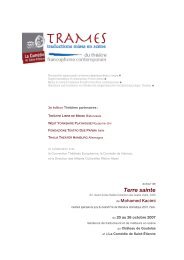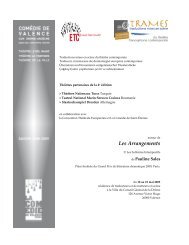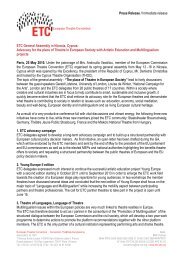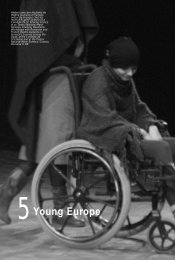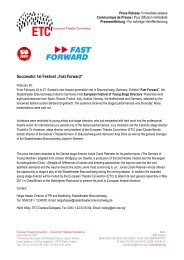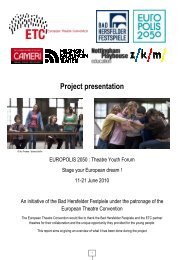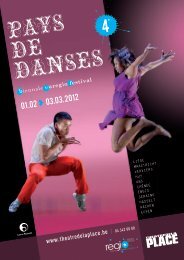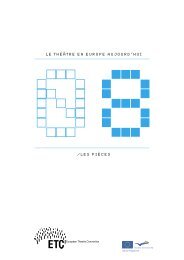Le théâtre en Europe aujourd'hui - European Theatre Convention
Le théâtre en Europe aujourd'hui - European Theatre Convention
Le théâtre en Europe aujourd'hui - European Theatre Convention
You also want an ePaper? Increase the reach of your titles
YUMPU automatically turns print PDFs into web optimized ePapers that Google loves.
slov<strong>en</strong>ia<br />
> slov<strong>en</strong>ija<br />
slovénie<br />
+ info<br />
> www.etc-cte.org<br />
142<br />
><br />
WORKS/ŒUVRES<br />
Nori casi ‘Crazy Times’; Akviziter<br />
‘Door to Door’<br />
PREMIERE/CRÉATION<br />
Prešernovo gledališce Kranj<br />
24.05.06<br />
PUBLISHER/EDITEUR<br />
Sodobnost Review (LXIX,<br />
May-June 2005)<br />
Suhadolcanava 64a<br />
1000 Ljubljana<br />
AWARDS/PRIX<br />
Grum Award for Best Text of the<br />
Year/Prix « Grum » pour le meilleur<br />
texte de l’année (2005)<br />
CHARACTERS/PERSONNAGES<br />
5 male/hommes<br />
1 female/femme<br />
+ voices/voix (off)<br />
Matjaž Briški 1973<br />
križ<br />
the cross<br />
la croix<br />
The Cross by Matjaž Briški imagines what would have happ<strong>en</strong>ed<br />
to Christ and his followers if the ev<strong>en</strong>ts had tak<strong>en</strong> place here and<br />
now. It op<strong>en</strong>s with a pair of appr<strong>en</strong>tice carp<strong>en</strong>ters busy erecting<br />
a cross at the crossroads of “some hamlet long forgott<strong>en</strong> by God<br />
and m<strong>en</strong>”. Their conversation is full of word play – in Slov<strong>en</strong>ian,<br />
the word ‘cross’ has many meanings and is used in many idiomatic<br />
expressions. One after another, the differ<strong>en</strong>t meanings appear and<br />
by the second sc<strong>en</strong>e the play has shifted into what appears to be<br />
something tak<strong>en</strong> from the theatre of the absurd. Two characters<br />
<strong>en</strong>ter, Mother and Son. Mother is in a wheelchair and Son is giving<br />
her a foot massage – though she has no feet – until somehow the<br />
sc<strong>en</strong>e turns into a murder-suicide, with Son strangling Mother and<br />
hanging himself. Christ th<strong>en</strong> steps down from the cross, places<br />
Son on it, and revives Mother. In the third act, the carp<strong>en</strong>ters<br />
return, wanting to become saints: they wash Mother’s feet and<br />
miraculously she can walk again. In the fourth act, Christ takes<br />
Son down from the cross, gives him to Mother, and nails himself<br />
back onto it. Ultimately, the Master Carp<strong>en</strong>ter arrives, and Christ<br />
becomes his appr<strong>en</strong>tice. The Cross <strong>en</strong>ds up in the other world and in<br />
this final sc<strong>en</strong>e, the characters find themselves in an uncomfortable<br />
state, where there are “no living, no dead, only memories”. The play<br />
is unique in its facility with language – it deftly manipulates words,<br />
levels and tones, playfully displaying a thorough knowledge of both<br />
religious tradition and Slov<strong>en</strong>ian linguistic and cultural background.<br />
La pièce débute avec une scène où des appr<strong>en</strong>tis charp<strong>en</strong>tiers<br />
élèv<strong>en</strong>t une croix avec une sculpture <strong>en</strong> bois du Christ au carrefour<br />
d’un « hameau quelconque oublié par Dieu et les hommes ».<br />
L’atmosphère est étrange et même grotesque, lorsque les<br />
charp<strong>en</strong>tiers accompagn<strong>en</strong>t leur travail de plaisanteries et de jeux<br />
de mots. (Il faut savoir que le mot « croix » a des significations<br />
diverses et multiples <strong>en</strong> slovène). <strong>Le</strong>s différ<strong>en</strong>tes significations<br />
apparaiss<strong>en</strong>t l’une après l’autre et <strong>en</strong>traîn<strong>en</strong>t la pièce dans la<br />
deuxième scène vers un <strong>théâtre</strong> de l’absurde où un fils masse les<br />
pieds de sa mère, qui se trouve – sans pieds - dans une chaise<br />
roulante, avant de l’étrangler. <strong>Le</strong> Christ desc<strong>en</strong>d de la croix, y fait<br />
monter le fils et ressuscite la mère. <strong>Le</strong>s charp<strong>en</strong>tiers revi<strong>en</strong>n<strong>en</strong>t et<br />
souhait<strong>en</strong>t dev<strong>en</strong>ir des saints. Ils accompliss<strong>en</strong>t le miracle de faire<br />
marcher la mère. <strong>Le</strong> Christ desc<strong>en</strong>d <strong>en</strong>suite le fils de la croix pour<br />
le r<strong>en</strong>dre à sa mère. Lorsque le maître charp<strong>en</strong>tier arrive, le Christ<br />
devi<strong>en</strong>t son appr<strong>en</strong>ti. La croix finit dans un autre monde : un lieu<br />
d’innoc<strong>en</strong>ce blanc comme neige. <strong>Le</strong>s personnages se trouv<strong>en</strong>t alors<br />
dans un état inconfortable où ils ne sont « ni vivants, ni morts,<br />
seulem<strong>en</strong>t des mémoires ». La pièce joue de manière unique avec la<br />
langue et faisant preuve d’une grande connaissance des traditions<br />
religieuses, linguistiques et culturelles slovènes.




